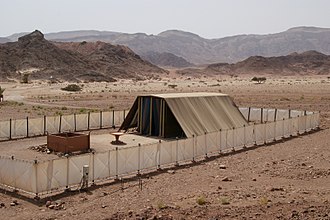Tabernacle
Tabernacle refers to the portable sanctuary that the Israelites carried with them during their wanderings in the desert after the Exodus from Egypt. It served as a place of worship and a symbolic dwelling place of God among His people. The construction and details of the Tabernacle are described in the Book of Exodus, specifically in chapters 25–31 and 35–40.
Design and Structure
The Tabernacle was designed as a portable structure, consisting of a rectangular enclosure within a larger courtyard. The enclosure was made of finely woven linen and other materials such as goat hair and ram skins dyed red. The structure was supported by frames of acacia wood, overlaid with gold, and connected by bars and sockets.
The interior was divided into two sections: the Holy Place and the Most Holy Place (or Holy of Holies). The Holy Place housed the Table of Showbread, the Menorah (seven-branched lampstand), and the Altar of Incense. The Most Holy Place, separated from the Holy Place by a veil, contained the Ark of the Covenant, which held the Tablets of the Law, Aaron's rod, and a pot of manna.
Function and Significance
The Tabernacle served multiple functions in the Israelite community. It was a place of sacrifice, prayer, and meeting with God. It symbolized God's presence among His people and His journey with them. The detailed instructions for its construction and the materials used underscored the holiness of God and the need for the Israelites to approach Him with reverence and purity.
Priests, specifically from the tribe of Levi, were appointed to serve in the Tabernacle. The high priest, initially Aaron, had exclusive access to the Most Holy Place, entering only once a year on the Day of Atonement to make atonement for the sins of the people.
Historical Context
The Tabernacle was central to the Israelite religion until the construction of the First Temple in Jerusalem by King Solomon. After the establishment of the Temple, the Tabernacle's role diminished, and its materials and furnishings were likely integrated into the Temple worship.
Legacy
The Tabernacle has been a subject of fascination and study in Jewish and Christian traditions. It is seen as a precursor to the Temple in Jerusalem and a symbol of God's desire to dwell among His people. The detailed descriptions of the Tabernacle have inspired various theological interpretations and artistic representations throughout history.
This article is a Christianity-related stub. You can help WikiMD by expanding it!
Transform your life with W8MD's budget GLP-1 injections from $125.
W8MD offers a medical weight loss program to lose weight in Philadelphia. Our physician-supervised medical weight loss provides:
- Most insurances accepted or discounted self-pay rates. We will obtain insurance prior authorizations if needed.
- Generic GLP1 weight loss injections from $125 for the starting dose.
- Also offer prescription weight loss medications including Phentermine, Qsymia, Diethylpropion, Contrave etc.
NYC weight loss doctor appointments
Start your NYC weight loss journey today at our NYC medical weight loss and Philadelphia medical weight loss clinics.
- Call 718-946-5500 to lose weight in NYC or for medical weight loss in Philadelphia 215-676-2334.
- Tags:NYC medical weight loss, Philadelphia lose weight Zepbound NYC, Budget GLP1 weight loss injections, Wegovy Philadelphia, Wegovy NYC, Philadelphia medical weight loss, Brookly weight loss and Wegovy NYC
|
WikiMD's Wellness Encyclopedia |
| Let Food Be Thy Medicine Medicine Thy Food - Hippocrates |
Medical Disclaimer: WikiMD is not a substitute for professional medical advice. The information on WikiMD is provided as an information resource only, may be incorrect, outdated or misleading, and is not to be used or relied on for any diagnostic or treatment purposes. Please consult your health care provider before making any healthcare decisions or for guidance about a specific medical condition. WikiMD expressly disclaims responsibility, and shall have no liability, for any damages, loss, injury, or liability whatsoever suffered as a result of your reliance on the information contained in this site. By visiting this site you agree to the foregoing terms and conditions, which may from time to time be changed or supplemented by WikiMD. If you do not agree to the foregoing terms and conditions, you should not enter or use this site. See full disclaimer.
Credits:Most images are courtesy of Wikimedia commons, and templates, categories Wikipedia, licensed under CC BY SA or similar.
Contributors: Prab R. Tumpati, MD






